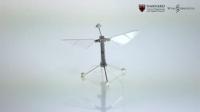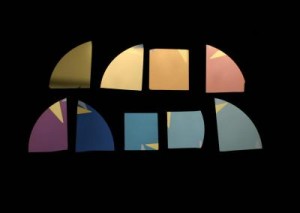The flight of Chirarattananom’s RoboBee took place last summer but the research has only now been published. There’s a May 2, 2013 news release on EurekAlert heralding this robotic first from 2012,
In the very early hours of the morning, in a Harvard robotics laboratory last summer, an insect took flight. Half the size of a paperclip, weighing less than a tenth of a gram, it leapt a few inches, hovered for a moment on fragile, flapping wings, and then sped along a preset route through the air.
Like a proud parent watching a child take its first steps, graduate student Pakpong Chirarattananon immediately captured a video of the fledgling and emailed it to his adviser and colleagues at 3 a.m.—subject line, “Flight of the RoboBee.”
“I was so excited, I couldn’t sleep,” recalls Chirarattananon, co-lead author of a paper published this week in Science.
The demonstration of the first controlled flight of an insect-sized robot is the culmination of more than a decade’s work, led by researchers at the Harvard School of Engineering and Applied Sciences (SEAS) and the Wyss Institute for Biologically Inspired Engineering at Harvard.
Here’s what it looks like,

The tiny robot flaps its wings 120 times per second using piezoelectric actuators — strips of ceramic that expand and contract when an electric field is applied. Thin hinges of plastic embedded within the carbon fiber body frame serve as joints, and a delicately balanced control system commands the rotational motions in the flapping-wing robot, with each wing controlled independently in real-time.
Credit: Kevin Ma and Pakpong Chirarattananon, Harvard University.
The Harvard [University] Gazette May 2, 2013 article by Caroline Perry, which originated the news release, provides more detail about what makes this particular robotic work unique,
“We had to develop solutions from scratch, for everything,” explains Wood [Robert J. Wood, Charles River Professor of Engineering and Applied Sciences at SEAS, Wyss core faculty member, and principal investigator of the National Science Foundation-supported RoboBee project]. “We would get one component working, but when we moved onto the next, five new problems would arise. It was a moving target.”
Flight muscles, for instance, don’t come prepackaged for robots the size of a fingertip.
“Large robots can run on electromagnetic motors, but at this small scale you have to come up with an alternative, and there wasn’t one,” says co-lead author Kevin Y. Ma, a graduate student at SEAS.
The tiny robot flaps its wings with piezoelectric actuators — strips of ceramic that expand and contract when an electric field is applied. Thin hinges of plastic embedded within the carbon fiber body frame serve as joints, and a delicately balanced control system commands the rotational motions in the flapping-wing robot, with each wing controlled independently in real time.
At tiny scales, small changes in airflow can have an outsized effect on flight dynamics, and the control system has to react that much faster to remain stable.
While it’s called the RoboBee project, the researchers’ inspiration for this prototype is a fly. Unlike most flies, this one is tethered, at least for now (from Perry’s article),
The prototypes are still tethered by a very thin power cable because there are no off-the-shelf solutions for energy storage that are small enough to be mounted on the robot’s body. High-energy-density fuel cells must be developed before the RoboBees will be able to fly with much independence.
Future research plans include (from Perry’s article),
… integrating the parallel work of many different research teams that are working on the brain, the colony coordination behavior, the power source, and so on, until the robotic insects are fully autonomous and wireless.
Here’s a citation for and a link to the research paper,
Controlled Flight of a Biologically Inspired, Insect-Scale Robot by Kevin Y. Ma, Pakpong Chirarattananon, Sawyer B. Fuller, and Robert J. Wood. Science 3 May 2013: Vol. 340 no. 6132 pp. 603-607 DOI: 10.1126/science.1231806
The paper is behind a paywall.
On reading about the RoboBee project I was reminded of Michael Crichton’s 2002 cautionary tale, Prey, which focuses on a possible future where small, swarming bots that fly threaten to take over the world. More happily, I was also inspired musically and found this rendition of the Flight of the Bumblebee,
Have a nice Friday, May 3, 2013!
